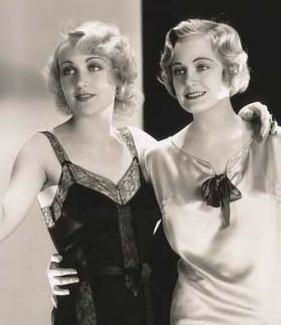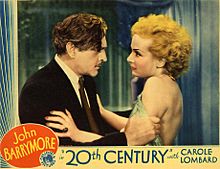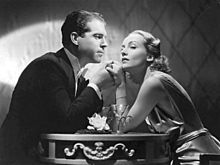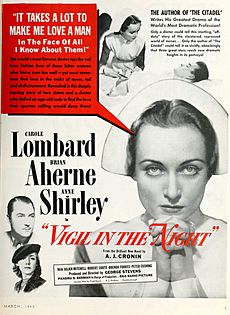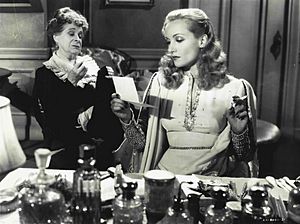Carole Lombard facts for kids
Quick facts for kids
Carole Lombard
|
|
|---|---|
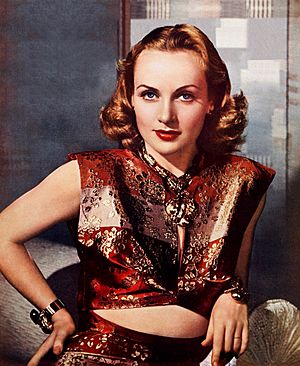 |
|
| Born |
Jane Alice Peters
October 6, 1908 Fort Wayne, Indiana, U.S.
|
| Died | January 16, 1942 (aged 33) Mount Potosi, Nevada, U.S.
|
| Resting place | Forest Lawn Memorial Park, Glendale, California, U.S. |
| Occupation | Actress |
| Years active | 1921–1942 |
| Political party | Democratic |
| Spouse(s) | |
Carole Lombard (born Jane Alice Peters; October 6, 1908 – January 16, 1942) was a famous American actress. She was especially known for her lively and often funny roles in movies called screwball comedies. In 1999, the American Film Institute named her one of the greatest female stars from the Golden Age of Hollywood. She was ranked 23rd on their list.
Carole Lombard grew up in Los Angeles with her mother. When she was 12, a director named Allan Dwan discovered her. She made her first movie, A Perfect Crime, in 1921. At 16, she signed a contract with Fox Film Corporation. But she mostly got small parts and left after a year.
Her career almost ended when she was 19. A car accident left a scar on her face. But she didn't give up! She made many short comedies for Mack Sennett. Then, she started appearing in bigger movies. These included High Voltage (1929) and The Racketeer (1929). After a successful role in The Arizona Kid (1930), she signed a contract with Paramount Pictures.
Paramount quickly made Lombard a leading actress. She mostly starred in drama films at first. Her fame grew when she married actor William Powell in 1931. But they divorced friendly after two years. A big moment in her career was starring in the comedy Twentieth Century (1934). She found her true talent in this type of funny movie.
Carole Lombard continued to shine in comedies like Hands Across the Table (1935). She often worked with Fred MacMurray in popular films. She was even nominated for an Academy Award for Best Actress for My Man Godfrey (1936). Another hit was Nothing Sacred (1937). Around this time, Lombard married Clark Gable, who was known as "The King of Hollywood." They became a very famous couple. Lombard later tried more serious roles, hoping to win an Oscar. But she returned to comedy in Mr. & Mrs. Smith (1941) and To Be or Not to Be (1942). This last film was released after her death.
Carole Lombard's career ended too soon. She died at age 33 in a plane crash. This happened while she was returning from a tour to sell war bonds. Today, she is remembered as one of the best actresses in screwball comedies. She is also an important figure in American cinema.
Contents
Life and Career of Carole Lombard
Early Life and First Steps in Acting (1908–1926)
Carole Lombard was born Jane Alice Peters in Fort Wayne, Indiana, on October 6, 1908. She was the only daughter of Frederic and Elizabeth Peters. Her family was wealthy, so she had a comfortable childhood. In 1914, her mother moved with the children to Los Angeles. Her parents separated but never divorced. Her father continued to support them financially.
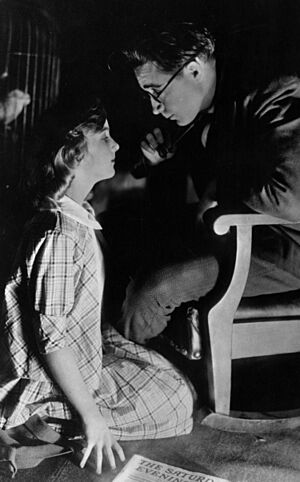
Carole was a lively girl who loved sports. She played baseball, tennis, volleyball, and swam. When she was 12, she was playing baseball and caught the eye of film director Allan Dwan. He thought she was perfect for a small role in his movie, A Perfect Crime (1921). Carole played the sister of actor Monte Blue. She loved the experience!
After her first movie, Carole wanted to act more. She tried out for many roles. When she was 15, she was noticed by someone working for Charlie Chaplin. She got a screen test for his film The Gold Rush (1925). She didn't get the part, but the test showed Hollywood her talent. She was told to change her first name because "Jane" was too plain. She chose "Carole" after a girl she knew.
In October 1924, at age 16, Carole signed a contract with the Fox Film Corporation. Her mother helped her get a screen test. Carole was so beautiful that the studio signed her for $75 a week. She dropped out of school to act. Fox liked the name Carole, but not her last name. So, she became Carole Lombard, using a friend's last name.
Most of Carole's roles at Fox were small parts in low-budget Westerns. She didn't like these roles much. She said she mostly had to "simper prettily at the hero and scream with terror." But she enjoyed other parts of filmmaking, like photo shoots and meeting other actors. She also loved going to nightclubs and won many dance competitions.
In March 1925, Fox gave Carole a main role in Marriage in Transit. Critics liked her performance, saying she had "good poise and considerable charm." However, the studio didn't think she was ready for leading roles. Her contract was not renewed. Later, in September 1927, Carole was in a car accident. The windshield shattered, cutting her face. She had surgery and learned to hide the scar with makeup and careful lighting.
Becoming a Comedy Star (1927–1935)
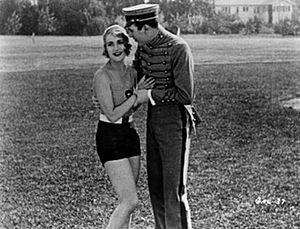
Even with her scar, Carole joined Mack Sennett's comedy company. She became one of the "Sennett Bathing Beauties." She appeared in 18 short comedies between 1927 and 1929. She loved her time there. These early comedy roles taught her a lot for her future career. She later called them "the turning point of [my] acting career."
Carole started getting bigger roles in feature films. She made a "good impression" in movies like Show Folks (1928). In 1929, she became a leading lady. Her role in Me, Gangster (1928) made her family proud. Her first "talking picture" was High Voltage (1929). She played a criminal stuck in the snow with other bus passengers. Her next film, Big News (1929), was a big hit. Critics said she did her "best work to date" in The Racketeer (1929).
Carole returned to Fox for one movie, the Western The Arizona Kid (1930). It was a big success. After this, Paramount Pictures signed her to a contract. She started at $350 a week, which grew to $3,500 a week by 1936! She starred in the comedy Safety in Numbers (1930). A critic called her an "ace comedienne." For her next film, Fast and Loose (1930), she was accidentally credited as "Carole Lombard." She liked it and kept the name.
In 1931, Carole made five films. Two of them, Man of the World and Ladies Man, starred William Powell. Carole was a big fan of his. They soon started dating and married on June 26, 1931. She said they were "diametrically different" but had a "perfect see-saw love."
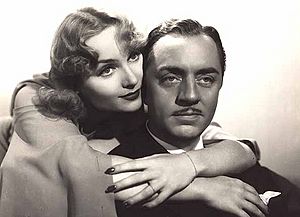
Being married to William Powell made Carole even more famous. Critics praised her work in films like I Take This Woman (1931). Many thought she would become a huge star. In 1932, she made five more films. No Man of Her Own was a big hit. She starred with Clark Gable, who was becoming a top star. This was the only movie they made together before they married. At the time, they weren't romantically interested in each other.
In August 1933, Carole and William Powell divorced. They had been married for 26 months. They remained good friends. Carole said their careers weren't the reason. She later said they were "just two completely incompatible people." She made five more films that year, including her only horror movie, Supernatural.
The year 1934 was very important for Carole. She starred in the musical drama Bolero with George Raft. She was offered the lead role in It Happened One Night, but couldn't do it because of Bolero. Bolero was well-liked, and her next film, We're Not Dressing with Bing Crosby, was a box-office hit.
Then, director Howard Hawks chose her for his screwball comedy Twentieth Century. This movie changed her career and made her a huge star. Hawks had seen her at a party and thought she was "hilarious." She starred opposite John Barrymore. At first, her acting was stiff. But Hawks told her to relax and be herself. She did, and critics loved her "fiery talent."
Carole continued to make successful films. She reunited with George Raft for Rumba (1935). Then, she starred in Hands Across the Table (1935) with Fred MacMurray. She played a manicurist looking for a rich husband. Critics praised the film, and it became one of her best. Carole and Fred MacMurray were so popular together that they made three more movies.
Top Star and Second Marriage (1936–1940)
In 1936, Carole starred in Love Before Breakfast. Her second comedy with Fred MacMurray was The Princess Comes Across. In this film, she played an actress pretending to be a Swedish princess. Critics loved her performance. Carole's success continued when she starred in the screwball comedy My Man Godfrey (1936). Her ex-husband, William Powell, insisted she play the lead role. He thought she would be perfect as Irene, a quirky heiress. The director told her to use her "eccentric nature" for the role. She worked hard on her expressions.
My Man Godfrey was a huge hit and received six nominations at the 9th Academy Awards. Carole was nominated for Best Actress. Many people say this was her best performance. It clearly showed her as a top comedienne.
By 1937, Carole was one of Hollywood's most popular actresses. She was also the highest-paid star in Hollywood! She earned $450,000, which was more than five times the U.S. President's salary. She told the press that 80 percent of her earnings went to taxes. She said she was happy to help her country. These comments brought her a lot of good attention. President Franklin D. Roosevelt even sent her a personal thank-you letter.
Her first film of 1937 was Swing High, Swing Low with Fred MacMurray. It was a success. For her next movie, Nothing Sacred, Carole returned to screwball comedy. She played a small-town girl who pretends to be dying. Her story is used by a New York reporter. This film was her only one in Technicolor. It was highly praised and one of Carole's favorites.
Carole continued with funny movies. Her next film was True Confession (1937). She played a woman who wrongly confesses to murder. She loved the script and was excited to work with John Barrymore and Fred MacMurray again. The movie was a hit with critics and audiences.

True Confession was Carole's last film under her Paramount contract. After that, she worked independently. Her next film, Fools for Scandal (1938), was a comedy that critics hated and audiences didn't go to see.
Carole spent much of 1938 focusing on her relationship with Clark Gable. They had reconnected at a party in 1936 and started dating. The media was very interested in them. Clark Gable was still married, but his wife eventually agreed to a divorce. The divorce was final in March 1939. Clark and Carole then eloped in Kingman, Arizona, on March 29. They bought a ranch in Encino, California. They loved the outdoors and had farm animals. Carole wanted to start a family right away, but she was unable to have children.
Carole decided to try more serious roles again. She starred with James Stewart in Made for Each Other (1939). Critics praised her acting, but the movie didn't make much money. Her next film was In Name Only (1939) with Cary Grant. She played a woman in love with a married man. She was paid $150,000 for this film.
Carole really wanted to win an Academy Award. She chose her next movie, Vigil in the Night (1940), hoping it would bring her the award. She played a nurse facing many challenges. Her performance was good, but the movie was too serious for audiences. She didn't get a nomination. Realizing comedies were her strength, she made one more drama, They Knew What They Wanted (1940), which was mildly successful.
Final Films (1941–1942)
Carole accepted that her name didn't sell tickets for serious movies. So, she returned to comedy after three years. She filmed Mr. & Mrs. Smith (1941) with Robert Montgomery. It was about a couple who find out their marriage isn't valid. Carole helped convince Alfred Hitchcock to direct this film. It was a commercial success.
It was almost a year before Carole made another movie. She focused on her home and marriage. She wanted her next film to be a huge hit. She chose To Be or Not to Be (1942). This was a dark comedy that made fun of the Nazis taking over Poland. Carole had always wanted to work with Ernst Lubitsch, her favorite comedy director. She felt the movie's topic was important, even if it was controversial. Carole played actress Maria Tura. Filming was one of the happiest times in her career.
Carole Lombard's Death
When the U.S. entered World War II in late 1941, Carole Lombard traveled to her home state of Indiana. She went there for a war bond rally. She was with her mother, Bess Peters, and Clark Gable's press agent, Otto Winkler. Carole helped raise over $2 million for the war effort in just one evening.
Her group was supposed to return to Los Angeles by train. But Carole wanted to get home faster, so she wanted to fly. Her mother and Winkler were scared of flying. Carole suggested they flip a coin to decide. They agreed, and Carole won the coin toss.
In the early morning of January 16, 1942, Carole, her mother, and Winkler boarded a plane. It was a Transcontinental and Western Air Douglas DST aircraft. After stopping to refuel in Las Vegas, TWA Flight 3 took off. It crashed into Double Up Peak near Mount Potosi, about 32 miles southwest of the Las Vegas airport. All 22 people on board died instantly. This included Carole, her mother, and 15 U.S. Army soldiers. Carole was 33 years old.
The crash happened because the flight crew couldn't properly navigate over the mountains. Safety beacons, which usually guide night flights, had been turned off. This was a precaution against possible enemy Japanese bomber planes. So, the pilots had no visual warnings of the mountains in their path. Some parts of the plane wreckage are still on Potosi Mountain today.
After the Crash
Carole Lombard's funeral was held on January 21 at Forest Lawn Memorial Park Cemetery in Glendale, California. She was buried next to her mother. Her grave is marked with the name Carole Lombard Gable. Even though Clark Gable married two more times after her death, he was buried next to Carole when he died in 1960.
Carole's last film, To Be or Not to Be, was still being finished when she died. It was a comedy about Nazism and World War II. There was a rumor that a line where Carole's character asks, "What can happen on a plane?" was cut from the film. But there's no proof that this line ever existed.
Carole had been scheduled to star in the film They All Kissed the Bride. After her death, Joan Crawford took her place. Joan Crawford donated all her salary from that film to the Red Cross. The Red Cross had helped a lot in recovering bodies from the plane crash.
Clark Gable was heartbroken by Carole's death. He joined the United States Army Air Forces. Carole had often asked him to join after the U.S. entered World War II. After training, Gable filmed combat missions in England. He flew five missions himself. In 1943, a Liberty ship was named in her honor. Clark Gable attended the launch of the SS Carole Lombard on January 15, 1944. This was two years after Carole's war bond drive. The ship later rescued hundreds of survivors from sunken ships in the Pacific.
-
Irene Dunne and Louis B. Mayer christen SS Carole Lombard while Clark Gable and Mrs. Walter Lang, Carole's secretary, look on.
Carole Lombard's Legacy
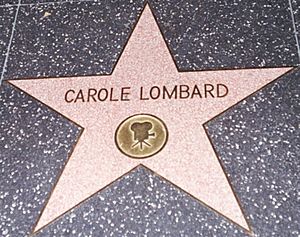
Author Robert D. Matzen said Carole Lombard was "among the most commercially successful and admired film personalities in Hollywood in the 1930s." George Raft, who acted with her, said, "I truly loved Carole Lombard. She was the greatest girl that ever lived."
Carole Lombard was known for her wild and funny performances. People described her as a "natural prankster" and a "salty tongued straight-shooter." She was also one of the few stars loved by everyone who worked with her. Life magazine noted that her funny personality was also how she was in real life. They said her conversations were "brilliant" and filled with "screeches, laughs, growls."
Carole Lombard was also seen as a strong, independent woman. She balanced her glamorous image with a smart business sense. Photoplay magazine called her the "perfect example of a modern Career Girl." This was because she believed women had equal rights with men. In 1937, she wrote an article called "Carole Lombard tells: 'How I Live by a Man's Code'." In it, she encouraged women to "work - and like it." She said, "All women should have something worthwhile to do."
Carole was one of the first stars to work as a "freelancer." This meant she had more control over her career choices. She also made a deal where she took a lower salary but got a percentage of the movie's profits. This was a new idea in Hollywood. She also had control over her image and who designed her costumes. Carole's smart business decisions and easy-going nature helped her challenge the old studio system.
In 1999, the American Film Institute ranked Carole Lombard 23rd on its list of the 25 greatest American female screen legends. She has a star on the Hollywood Walk of Fame. She received one Academy Award for Best Actress nomination for My Man Godfrey. Many actresses have played her in movies and TV shows. Her childhood home in Fort Wayne is now a historic landmark. The city also named a bridge after her, the Carole Lombard Memorial Bridge.
Filmography
See also
 In Spanish: Carole Lombard para niños
In Spanish: Carole Lombard para niños


